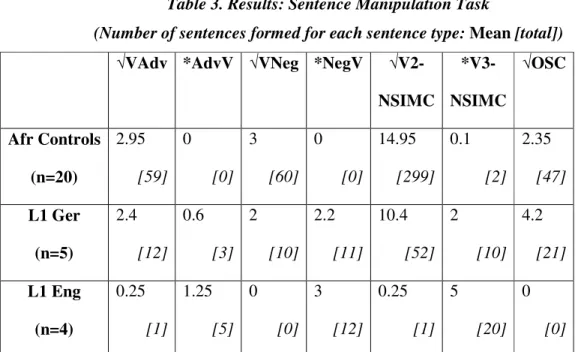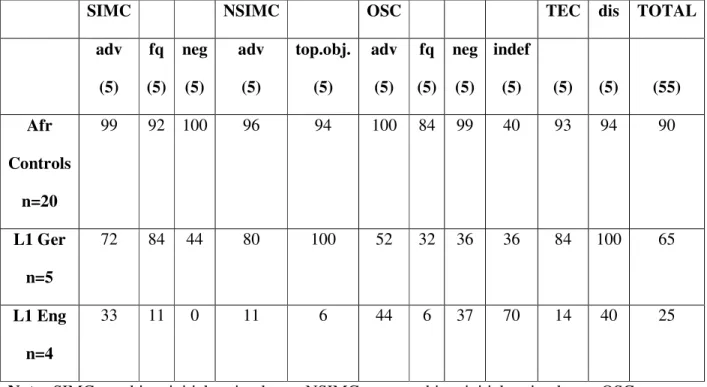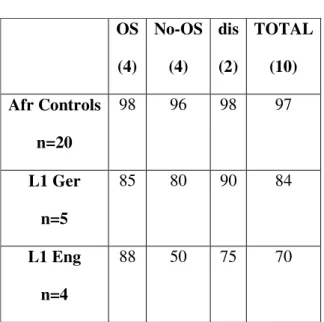First, although Icelandic is not one of the languages included in the study reported in this article, it is the language used to represent the [+SIP] languages in the source document (Bobaljik and Thráinsson 1998). Another property that BandT (1998) associates with the SIP setting is whether the verb is raised from the VP in non-V2 environments. Consequently, to determine the SIP setting in a language, one simply needs to determine whether the verb is raised from the VP in non-V2 environments.
Table 1 explicitly states that verb position relative to left edge markers only indicates SIP setting in non-V2 environments. Therefore, the position of the verb in V2 environments is related to the setting of the V2 parameter and not the SIP. The consequences of setting the V2 parameter are visible in non-subject initial main clauses (NSIMC).
The study: Ongoing research into the L2 acquisition of the SIP and the V2 parameter in Afrikaans. As mentioned in Chapter 1, the research reported here aimed to test the predictions of the FTFA regarding the L2 acquisition of the SIP and the V2 parameter,10 by comparing English-speaking learners of Afrikaans with German-speaking learners of the SIP. African. To determine the setting of the SIP and the V2 parameter in the interlingual (IL) grammars of L2 learners, they were asked to perform three tasks (in this order): a sentence manipulation task, a judgment task of grammaticality, and a short task to judge the truth. value judgment task. Examples of the test items for the sentence manipulation task and the grammaticality judgment task can be found in the appendix.
In the sentence manipulation task (based on that in White 1991), the subject was presented with a set of randomly shuffled Afrikaans word cards and asked to form a sentence that (s)he found acceptable using all the cards.
![Table 1. Consequences of the setting of the SIP [+SIP] [-SIP]](https://thumb-ap.123doks.com/thumbv2/pubpdfnet/10491675.0/5.918.250.679.935.1059/table-1-consequences-setting-sip-sip-sip.webp)
Participants
One cannot therefore really conclude anything based on the results obtained during this test session. These results are discussed directly below, and although statistical tests have not yet been performed on these data due to the very small student groups, the trends within the two groups are clear enough to warrant some discussion.
Results
The only surprising results, in terms of FTFA, involve SIMC negation items, in which the raising of a negative element appears to be optional for the German participants: they formed 10 SIMCs in which the verb precedes the negative element and 11 in which the verb follows the negative element. And this option is not the result of grouping individual results together; it is found for each of the German participants individually. This may have to do with the fact that learners are not sure which of the two negative elements in Afrikaans has semantic content (since German, like English, does not have a negative match).
As predicted by the FTFA, the English participants show exactly the opposite of the trends shown by the other two. The results of the grammaticality judgment task are given in table 4 as a percentage of correct judgments for each of the types of sentences. 16. African controls have almost perfect scores for all categories, except OS pairs involving an unspecified object, where they score only 40%.
Regardless of whether this account is valid, the English participants do even worse on the OS items than the German participants. They did not reject them because the object had the wrong semantic properties; rather, they rejected them for the same reason as they rejected the other OS items, namely because L1 does not allow OS, regardless of the semantic properties of the object.17. On all other categories in the grammatical judgment task, the predictions of the FTFA are confirmed in that the German participants' scores are much higher than the Eng participants' scores.
This is also true for SIMC items that include a negative element, although here the German participants' score is not as high as their other scores. If the total scores of all three groups are considered, the FTFA predictions are again confirmed in that the German participants did significantly better than the English participants. The results of the true value judgment task are given in Table 5 as a percentage of correct judgments for the different categories of this task.
The Afrikaans Kontroles' performance is once again almost perfect in all the categories and, as predicted by the FTFA, the German participants' scores are also high. The FTFA predicts that these learners will do well on the No-OS items and poorly on the OS items, since their L1 does not allow OS and for this reason they should not have knowledge of the semantic effects of OS. In Non-OSCs, on the other hand, as one can see in (22), there is no single element (such as the verb or the object) that is surrounded by the two negative elements.

Conclusion
This calculation leads them to the correct interpretation and gives them a high score on the OS items. Moreover, FTFA can easily explain the tendencies observed in both groups in all three tasks. In this way, these preliminary results provide some support for the 'full transfer' part of the FTFA.
Once more data has been collected, (i) statistical tests will be conducted to determine whether the observations regarding the groups of novice students discussed in this article apply to a larger group of novice students, and (ii) the data of the advanced students will be used to test the predictions of the 'full access' portion of the FTFA. For an analysis of the full data set and for more in-depth discussions of the issues raised in this article, the reader is referred to my Ph.D. In this dissertation, I argue that the additional data from the novice students support the conclusions drawn from the smaller data set in this article (i.e., the data are consistent with 'full transfer') and that the data from the advanced students support the claim of 'full access' from the FTFA.
The dissertation also includes data from L2 acquisition of SIP and the V2 parameter in French by adult African speakers. This assumption is actually untenable under the BandT framework and is made here simply to simplify the presentation of the study results in this paper. The tasks used in the study reported in Conradie (2002) differ slightly from those used in the study reported here and described in section 3.2, as some revisions were made after previous testing sessions (e.g. the inclusion of pairs of the OS test involving an unspecified object in the grammar judgment task).
She used a truth value judgment task and an inferential production task and argues that the results of her study show that both child and adult L2s were able to acquire relevant L2 properties. See note 3 for reference to work that includes an analysis of individual participant performance as well as an investigation of FTFA's prediction that performance in related construction types (eg, OSC performance and TEC performance - both related to SIP deployment ) must be aggregated. The conclusions reached here are supported by a comparison of the two groups of students with each other rather than an analysis of the performance of each group separately.
Furthermore, the analysis of the two learning groups' scores on the OSC pairs in the grammaticality judgment task is supported by an error analysis performed on the larger dataset examined in my PhD. At first glance, the German-speaking students and the English-speaking students perform similarly in the OSC categories, both achieving low scores overall. However, an error analysis shows that the two L1 groups make different types of errors in these categories: most of the errors that the German-speaking learners make involve accepting only the OSC, while most of the errors that the English-speaking learners make involve only accept the non-OSC.
The fact that the performance of the group of English-speaking Non-OSC students on this task is at chance level is not the result of a bimodal distribution (ie, some students perform very well and other students perform very poorly); individual results show that all these students performed at chance level. The availability of Universal Grammar to adult and child learners: A study of the acquisition of German word order.


